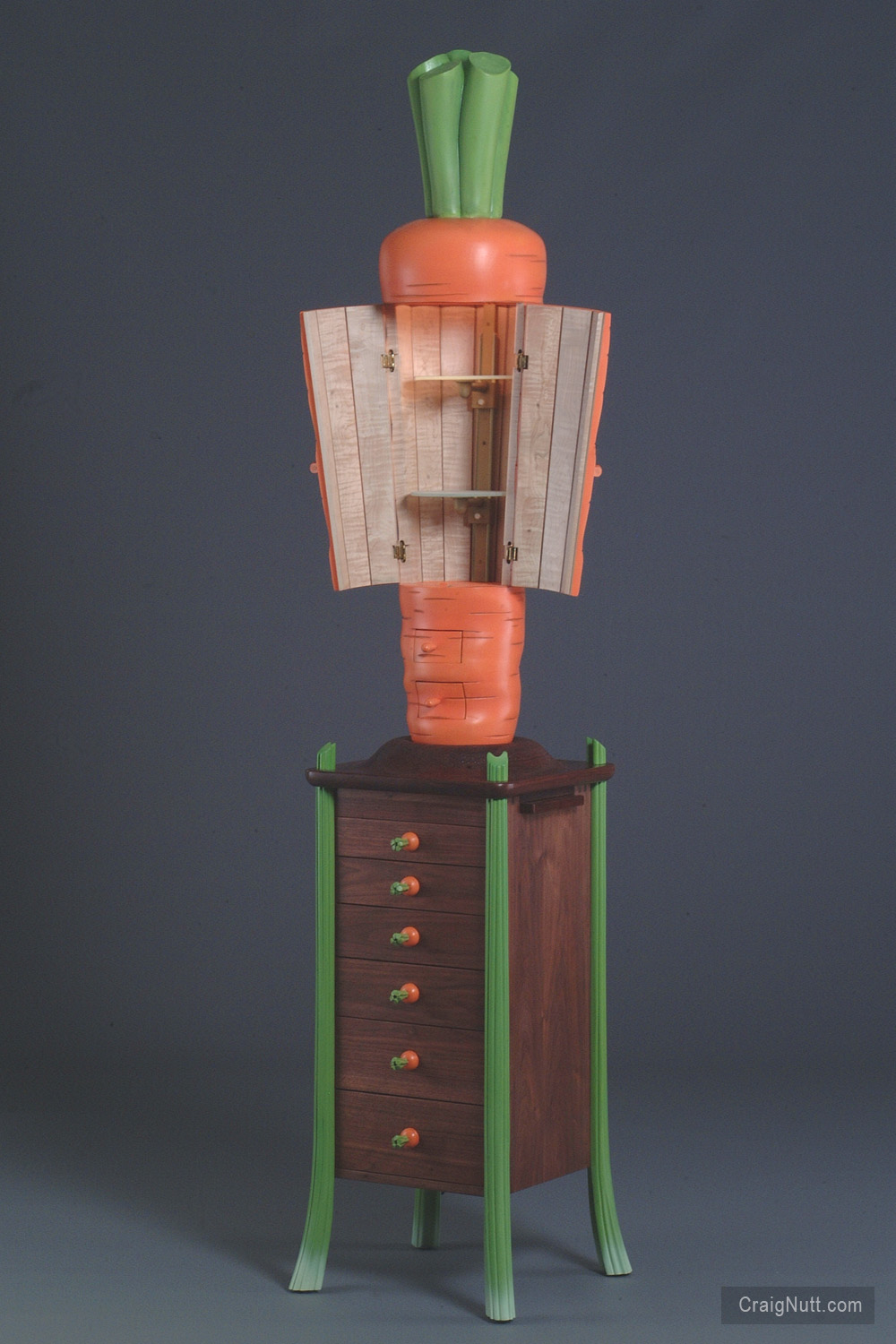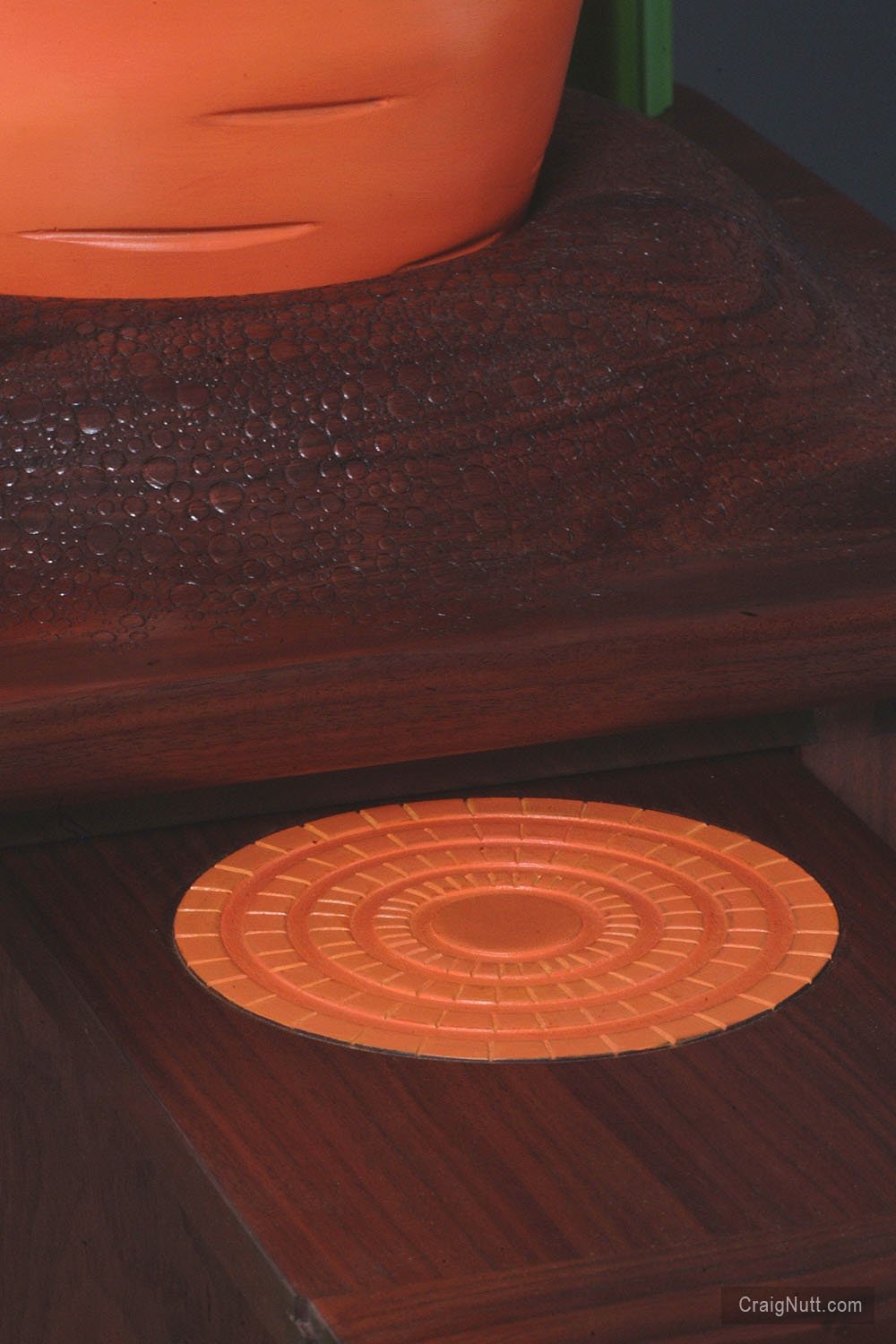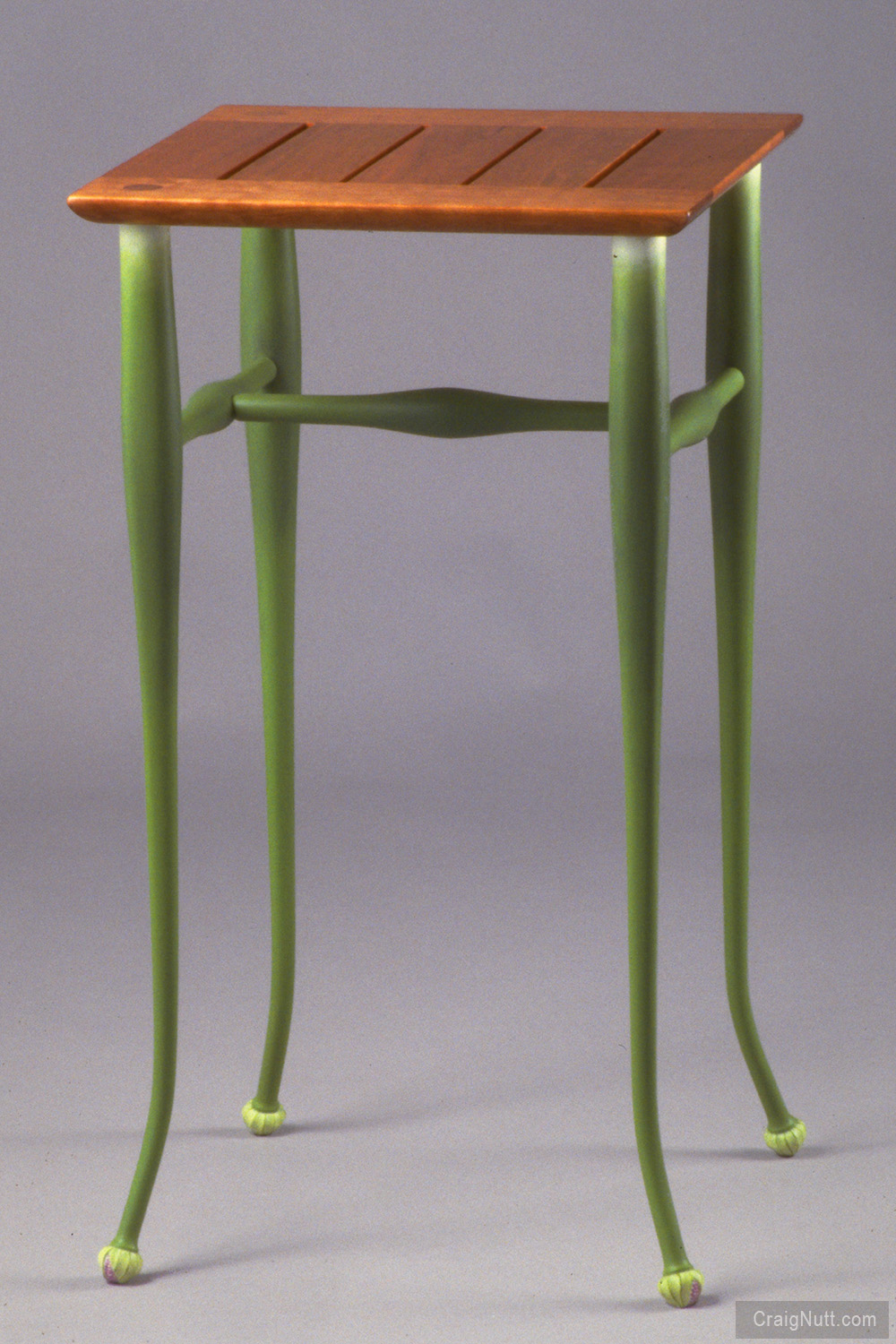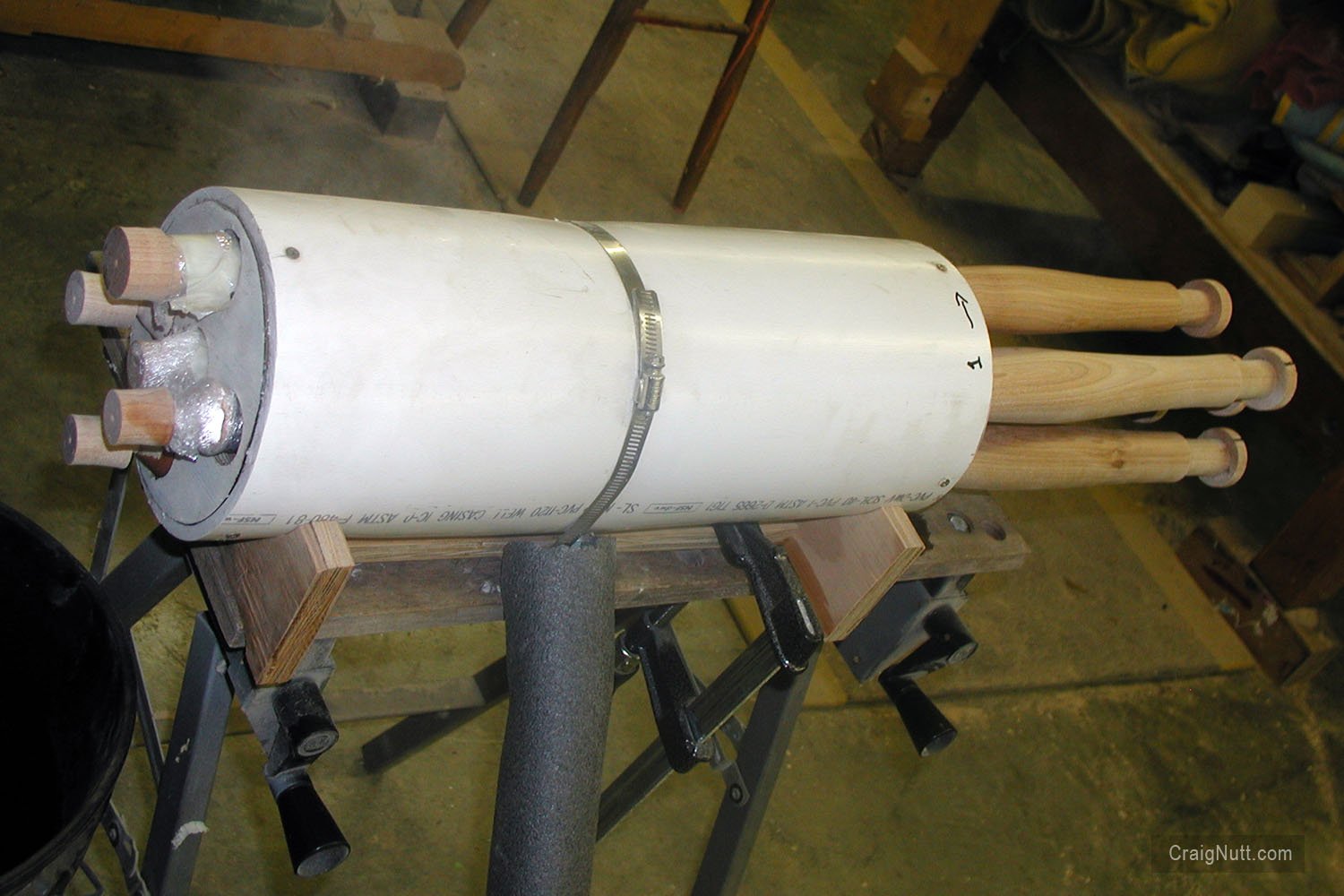A few days ago a notice popped up in my inbox about an auction that includes five of my works, each of which I consider important to my larger body of work.
I have to admit that I pretty much anticipated this happening after my death - so it feels a little like I’m unstuck in time, being chased by my past. Once you reach a certain age there are plenty of reminders of one’s mortality, and I guess this is the latest.
Rather than to dwell on my mortality or to contemplate what this means to the remainder of my career, I thought that this is a good time to remember these works and to put it in a form that might be helpful to those who may be contemplating giving one or more of them a new home.
CABINETS
Craig Nutt: Carrot Cabinet (open), 2000, 42”h. x 9”w. x 9”d., Oil paint on turned and carved wood.
CARROT CABINET - 2000
Craig Nutt: Carrot Cabinet (closed), this 3.-1/2 foot high cabinet became the prototype for a much larger clock for the Atlanta airport.
I started with a small cabinet, joining a coopered (as in barrel staves) center section to solid ends. The shelves mimic slices of carrot, but because the carrot tapers, 3 shelves were required to make them adjustable. I figured you might want two shelves as shown here, or one, requiring an extra shelf. Details like this and the proper title of the work seem to get missed when things go to auction. I’ve had a very small number of pieces turn up in auctions, but have never been contacted for this basic information.
This little cabinet became the prototype for a clock I later made for the Hartsfield-Jackson Atlanta International Airport.
My original intent was to make two of these cabinets. Parts of the carrot for a second cabinet occupied areas of my studio for about 22 years when they (turned upside -down) became the central support for a wall shelf unit in a very special commission. I guess you could say it is unique but has a fraternal twin.
SELECTED EXHIBITIONS featuring Carrot Cabinet
Studio Furniture: A Fine Art Invitational, 2000, Memphis College of Art.
Craig Nutt painting with oils.
ABOUT PAINT
I have used a number of paints and wood finishes over the years. When I began painting turned wood bowls to resemble pottery glaze effects, I used nitrocellulose furniture lacquer with various tints, dyes, and additives. Before making furniture I painted in oils, and when I started making vegetable-themed sculptures and furniture, I turned to artists’ oils to get the effects I was after. Nothing in nature is one color, and oil paint dries slowly enough to allow time for layering and blending wet.
I have also used acrylic and nitrocellulose lacquers applied with a spray gun and airbrush to get a smooth, glossy effect on vegetables such as peppers and celery. I don’t have any hard and fast rules, just what works for the piece.
NINE CARROT TREASURE CHEST - 2001
i designed this one-of-a-kind chest to function as a cabinet of curiosities-a place to store and display one’s treasures whether those be pieces of jewelry or specimens. It being a repository for treasures, the number of carrots seemed relevant when naming the work. The walnut lower case contains six hand-dovetailed drawers with full-extension glides and is supported by celery legs fastened to the corners of the dovetailed chest. The inside of the carrot display section is lined with curly maple and walnut. Floating glass and brass shelves supported by a runner at the back make it possible for the shelves to be positioned anywhere in the cabinet. There are also two small drawers in the carrot itself.
Craig Nutt: Nine Carrot Treasure Chest, 2001, 94”h.x20”w.x20”d., painted wood, walnut, maple, brass, lighting.
Craig Nutt: Nine Carrot Treasure Chest, detail showing carving of “dirt” mound.
Craig Nutt: Shaping part of Nine Carrot Treasure Chest on a large wood lathe.
Craig Nutt: Nine Carrot Treasure Chest (detail of drawers)
Craig Nutt: Nine Carrot Treasure Chest-A carrot slice tray slices out of cabinet side for examining and preparing treasures.
SELECTED EXHIBITIONS featuring Nine Carrot Treasure Chest
Function Follows Form: Artist-Made Furniture (curated by Wendell Castle), 2004, Craft Alliance, St. Louis.
Studio Art Furniture Invitational, 2002 Arkansas Art Center, Little Rock
Craig Nutt: Flying Objects & Tossed Salads, 2005, Southern Ohio Museum, Portsmouth.
CELERY CHAIRS - 1992/93 & 2005
I have made eighteen Celery Chairs with Peppers, Carrots, and Snow Pea-eight in 1992-93 and ten in 2005. From the first group, two are in public collections (Mobile Museum of Art & Art Museum of South Texas in Corpus Christi). The rest of the first group are in private collections and all of the second group are in private collections including a pair in my personal collection. The pair in this auction are from Ann and Gordon Getty’s collection.
The chairs were designed with pepper legs and carrot spindles or carrot legs and pepper spindles. All but a pair from the first group that was made from Swiss pear are painted and upholstered with leather in various vegetable-inspired hues.
Craig Nutt: Celery Chair with Peppers, Carrots, and Snow Pea, 2005, 37”h. x 25”w. x 22”d., Acrylic lacquer on carved wood, leather.
Craig Nutt: Celery Chair with Carrots, Peppers,, and Snow Pea, 2005, 37”h. x 25”w. x 22”d., Acrylic lacquer on carved wood, leather.
CARVING
Virtually every piece of the chair is carved-and with chairs that will be used in pairs or a set, consistency is important. Patience and endurance is always an issue in studio furniture making, but even more so when it involves many months of labor, as these did..
The celery stalks are particularly challenging because they twist between the seat and the top. Much of the shaping below the seat can be done with multiple power tool operations, but the twisted section and the joint with the hip rail has to be carved by hand.. As they say, “the devil is in the details!”
Craig Nutt carving a Celery Chair leg.
Craig Nutt: several Celery Chair legs mostly carved.
Craig Nutt: Celery Chair detail.
ABOUT THE UPHOLSTERY
Craig Nutt skiving leather with a manual skiving machine. I found this by talking to bookbinders, who use these or hand skiving knives. Look for this detail on finely made leather goods.
“Full Grain” leather is the best because it still has its strong top layer intact. “Top grain” leather and suede is made from the weaker underlayers that remain when a hide is split. This is important in skiving leather as the leather is taken down in thickness almost to the top layer. If you count the layers where the seat, welt, and gusset come together, there are five, which would be very thick and difficult to conceal where they all come together under the welt.
Many of my pieces were influenced by ancient Egyptian furniture. Some of the chairs discovered in King Tut’s tomb had seats that swept up at the corners, mimicking draped animal skins. I wanted these chairs to have a similar, though less-pronounced sweep. Consequently, it was very important that the upholstery be very crisp with attention paid to every detail. When I sent the first chair out to be upholstered, in 1992, just before I took it to a show, I was very disappointed in the details. Folded leather telegraphed through and there were lumps that distracted from the lines. I met a master leather worker at the show, and after the show, I drove to his studio several states away where he showed me how to skive leather-shaving down the thickness of the leather where several thicknesses of leather came together as on welts.
Upholsterer, Janet Mills pulling the felt-backed gusset over a strip of cardboard to get a sharp edge.
I also became acquainted with Janet Mills, an upholsterer in Alabama where I lived at the time. She had been a seamstress, and she totally understood my desire to make the upholstery on these chairs extraordinary. I would come to her shop with my razor blades and skiving rig and try to stay ahead of her, skiving leather for welts and gussets.. I made hardware to press the leather into the hollows of the celery stalks, and a pearwood tool to tuck the leather behind it. Where the other upholsterer had folded cords over, she tucked the skived leather into the end so the welts fit neatly into the celery stalks.
SELECTED EXHIBITIONS featuring Celery Chairs
Traditions/innovation: American Masterpieces of Southern Craft, 2008-13, SouthArts. Traveled to 15 museums in cities across the Southeast including Atlanta, Knoxville, Louisville , Asheville, Pensacola and Savannah.
Craig Nutt: Certified Organic, 2008, Mobile Museum of Art.
Please Be Seated: Masters of the Art of Seating, 1995, Flagler Museum, Palm Beach, FL.
Celebrating the Creative Spirit: Contemporary Southeastern Furniture, 1998-2001, Mobile Museum of Art, Telfair Museum of Art, , Montgomery Museum of Fine Art, Museum of Western Virginia, Columbus Museum, Mississippi Museum of Art.
Onion Blossom Table - 1995-2002
I originally designed this table with the idea of using it as a display pedestal for my “Flying Vegetable” sculptures, though I do not know if any, except my own have been used for this. I have made twenty or so over these years, some in different sizes and proportions, but the one shown here is the size I prefer myself.
I usually have some onions in my garden that have overwintered and they bloom in the late spring or early summer.. The plant sends up a long central stalk that is bulbous at its base, resembling the turnings in the undercarriage of a Windsor chair. That suggested the basic construction of the table, along with a slatted top borrowed from one of the chairs in Tut’s tomb.
The blossom end at the bottom of the table legs is closed, and two on each table are just beginning to open. It is a detail that you might not notice unless you are on the floor looking up at the table-something I often see my clients doing. The cherry top is finished with an oil and phenolic resin varnish that is easy to repair. The legs are painted with artist’s oils. A subtle detail is a slight ridge that runs down the corner of the upper part of the leg-just so it is not exactly round.
The legs, being long and thin are challenging to turn because they tend to whip on the lathe. The legs are steam-bent, a process to which the birch in the legs is well-suited. However, the change in dimension at the bottom of the legs presents some challenges in drying after the wood is steamed.
Their relatively simple design made the price fairly modest compared to most of my work.Most of these tables sold for $3,000-$4,000 when they were made 20 years or so ago.
Craig Nutt: Onion Blossom Table, 2005, 29”h. x 16”w. x 16”d., Cherry top with turned , carved, and painted birch legs.
Craig Nutt: Steaming Onion Blossom Table legs. The steam chamber is built to steam only the sections of the legs that will be bent.
Craig Nutt: Steam bending Onion Blossom Table legs. When steamed for an appropriate amount of time, the wood becomes briefly pliable, and can be permanently bent to a particular shape. A percentage of the attempted bends fail due to variables like wood grain, time, and even whether the bend is made smoothly.
Craig Nutt: Onions blooming in the garden.
Craig Nutt: ;Onion Blossom Table detail. Two feet on each table have blossoms just beginning to open.
SELECTED EXHIBITIONS featuring Onion Blossom Tables
Objects for Use: Handmade by Design, 2001, American Craft Museum, NYC.
Materials-Contemporary Illusions, 2002, Brookfield Craft Center, CT.
Food, Glorious Food: Artists and the Art of Eating, 1997, Wustum Museum (RAM), Racine, WI.
Craig Nutt: ‘Pataphysical Ponderings, Leu Art Gallery, Belmont University, Nashville, TN
CONCLUSION
My limited experience with seeing these auction notices or hearing from someone who has tracked me down from a signature on something they bought usually means that someone has died. This is unwelcome, and sometimes shocking news. Many of my customers are, or have become friends. These were sold nearly eighteen years ago, and the news of the customer’s death preceded the auction notice.
I made these pieces to last for generations partly as a statement of values and partly to launch them into the future. My first real experience with furniture was from working in an antique shop. The furniture I worked on often had the name of the child who would inherit it taped underneath. I especially love to hear about pieces that have been passed down to a new generation.
An auction seems to reduce everything to a sale price, so for a casual observer, it is easy to miss the important things about why and how the work was made, the adventure of making it, and all the human interactions that went along with it.
But, I have come home from auctions with objects I prize. I often wish I knew more about it and the person who made it. So I hope these pieces find good homes, and maybe some will find their way into public collections, too.




















